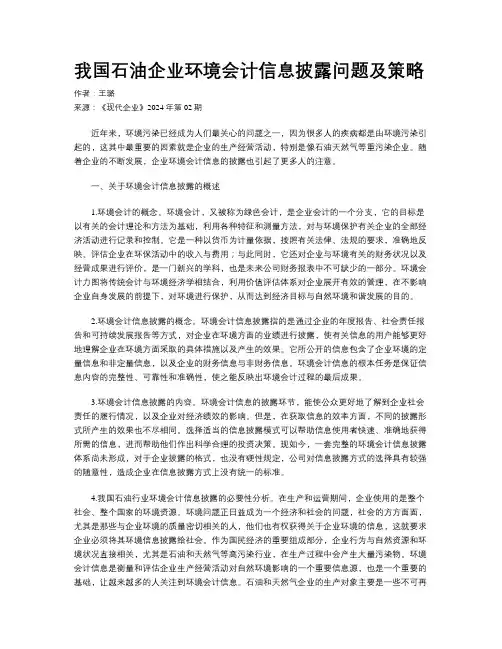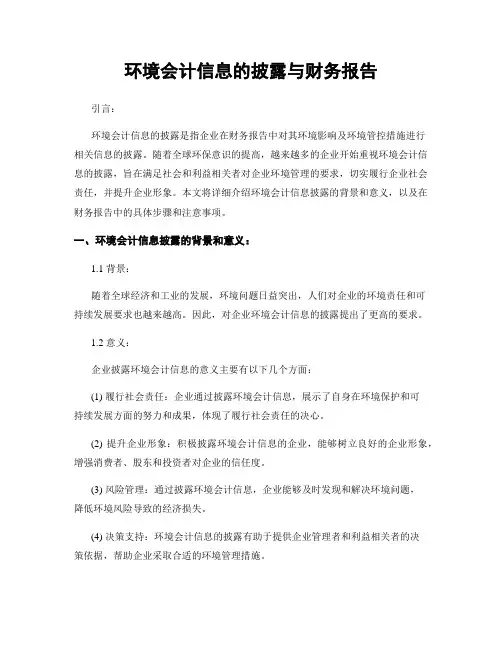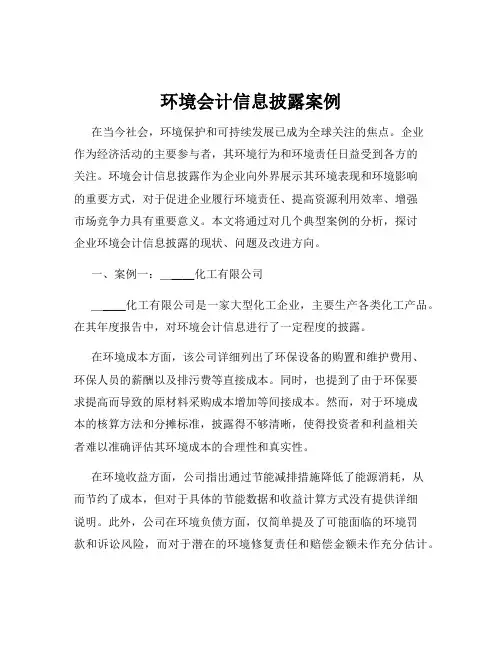环境会计信息披露
我国石油企业环境会计信息披露问题及策略

我国石油企业环境会计信息披露问题及策略作者:王璐来源:《现代企业》2024年第02期近年来,环境污染已经成为人们最关心的问题之一,因为很多人的疾病都是由环境污染引起的,这其中最重要的因素就是企业的生产经营活动,特别是像石油天然气等重污染企业。
随着企业的不断发展,企业环境会计信息的披露也引起了更多人的注意。
一、关于环境会计信息披露的概述1.环境会计的概念。
环境会计,又被称为绿色会计,是企业会计的一个分支,它的目标是以有关的会计理论和方法为基础,利用各种特征和测量方法,对与环境保护有关企业的全部经济活动进行记录和控制。
它是一种以货币为计量依据,按照有关法律、法规的要求,准确地反映、评估企业在环保活动中的收入与费用;与此同时,它还对企业与环境有关的财务状况以及经营成果进行评价,是一门新兴的学科,也是未来公司财务报表中不可缺少的一部分。
环境会计力图将传统会计与环境经济学相结合,利用价值评估体系对企业展开有效的管理,在不影响企业自身发展的前提下,对环境进行保护,从而达到经济目标与自然环境和谐发展的目的。
2.环境会计信息披露的概念。
环境会计信息披露指的是通过企业的年度报告、社会责任报告和可持续发展报告等方式,对企业在环境方面的业绩进行披露,使有关信息的用户能够更好地理解企业在环境方面采取的具体措施以及产生的效果。
它所公开的信息包含了企业环境的定量信息和非定量信息,以及企业的财务信息与非财务信息。
环境会计信息的根本任务是保证信息内容的完整性、可靠性和准确性,使之能反映出环境会计过程的最后成果。
3.环境会计信息披露的内容。
环境会计信息的披露环节,能使公众更好地了解到企业社会责任的履行情况,以及企业对经济绩效的影响。
但是,在获取信息的效率方面,不同的披露形式所产生的效果也不尽相同。
选择适当的信息披露模式可以帮助信息使用者快速、准确地获得所需的信息,进而帮助他们作出科学合理的投资决策。
现如今,一套完整的环境会计信息披露体系尚未形成,对于企业披露的格式,也没有硬性规定,公司对信息披露方式的选择具有较强的随意性,造成企业在信息披露方式上没有统一的标准。
环境会计信息的披露与财务报告

环境会计信息的披露与财务报告引言:环境会计信息的披露是指企业在财务报告中对其环境影响及环境管控措施进行相关信息的披露。
随着全球环保意识的提高,越来越多的企业开始重视环境会计信息的披露,旨在满足社会和利益相关者对企业环境管理的要求,切实履行企业社会责任,并提升企业形象。
本文将详细介绍环境会计信息披露的背景和意义,以及在财务报告中的具体步骤和注意事项。
一、环境会计信息披露的背景和意义:1.1 背景:随着全球经济和工业的发展,环境问题日益突出,人们对企业的环境责任和可持续发展要求也越来越高。
因此,对企业环境会计信息的披露提出了更高的要求。
1.2 意义:企业披露环境会计信息的意义主要有以下几个方面:(1) 履行社会责任:企业通过披露环境会计信息,展示了自身在环境保护和可持续发展方面的努力和成果,体现了履行社会责任的决心。
(2) 提升企业形象:积极披露环境会计信息的企业,能够树立良好的企业形象,增强消费者、股东和投资者对企业的信任度。
(3) 风险管理:通过披露环境会计信息,企业能够及时发现和解决环境问题,降低环境风险导致的经济损失。
(4) 决策支持:环境会计信息的披露有助于提供企业管理者和利益相关者的决策依据,帮助企业采取合适的环境管理措施。
二、环境会计信息的披露步骤:2.1 收集环境会计信息:企业需要收集包括各类环境成本和环境投资的信息。
环境成本包括直接成本和间接成本,如环境保护设备购置成本、环境治理费用、环境保护产品开发成本等。
环境投资则主要包括环境保护设施和技术研发的投资。
2.2 归集和分类:将收集到的环境会计信息进行归集和分类,确保信息的准确性和完整性。
可以根据环境成本的性质和用途进行分类,如环境污染防治成本、资源节约与循环经济成本等。
2.3 评估环境影响:评估环境会计信息对企业财务状况和经营绩效的影响。
以财务指标为基础,分析环境会计信息对企业利润、资产负债表和现金流量表的影响。
2.4 编制环境会计报告:根据归集和评估的环境会计信息,编制环境会计报告。
环境会计信息披露要点知识点总结

环境会计信息披露要点知识点总结一、环境会计信息披露的概念和重要性环境会计信息披露是指企业通过一定的方式和渠道,向利益相关者公开其在环境保护方面的财务和非财务信息。
随着全球对环境保护的重视程度不断提高,环境会计信息披露逐渐成为企业社会责任的重要组成部分。
其重要性主要体现在以下几个方面:首先,有助于提高企业的透明度和公信力。
通过披露环境会计信息,企业能够向社会展示其在环境保护方面的努力和成果,增强公众对企业的信任。
其次,促进企业的可持续发展。
环境会计信息可以帮助企业识别和管理环境风险,制定更有效的环境策略,从而实现经济与环境的协调发展。
再者,满足利益相关者的需求。
投资者、债权人、消费者等利益相关者越来越关注企业的环境表现,环境会计信息披露能够为他们的决策提供重要依据。
最后,推动环境保护事业的发展。
企业作为社会经济活动的主体,其环境会计信息披露有助于形成良好的社会监督氛围,促进整个社会的环境保护意识提升。
二、环境会计信息披露的内容(一)环境财务信息1、环境成本包括预防成本、治理成本、损害成本等。
例如企业为减少污染而投入的设备购置和运行费用、因环境污染导致的罚款和赔偿等。
2、环境收益如通过资源节约、废弃物回收利用等方式获得的经济收益。
3、环境负债企业因环境问题可能承担的债务,如预计的环境修复费用、环境诉讼赔偿等。
(二)环境绩效信息1、资源利用效率包括能源消耗、水资源消耗、原材料利用等方面的指标和数据。
2、污染排放情况如废气、废水、废渣等各类污染物的排放量和达标情况。
3、环境管理措施企业采取的环境管理制度、环保技术研发、员工环保培训等。
(三)环境政策和目标企业的环境方针、战略规划以及短期和长期的环境目标。
三、环境会计信息披露的方式(一)独立环境报告企业单独编制环境报告,全面、系统地披露环境会计信息。
(二)年度财务报告中的附注在财务报告的附注部分,对与环境相关的财务信息进行说明和解释。
(三)社会责任报告将环境会计信息作为社会责任报告的一部分进行披露。
环境会计信息披露案例

环境会计信息披露案例在当今社会,环境保护和可持续发展已成为全球关注的焦点。
企业作为经济活动的主要参与者,其环境行为和环境责任日益受到各方的关注。
环境会计信息披露作为企业向外界展示其环境表现和环境影响的重要方式,对于促进企业履行环境责任、提高资源利用效率、增强市场竞争力具有重要意义。
本文将通过对几个典型案例的分析,探讨企业环境会计信息披露的现状、问题及改进方向。
一、案例一:_____化工有限公司_____化工有限公司是一家大型化工企业,主要生产各类化工产品。
在其年度报告中,对环境会计信息进行了一定程度的披露。
在环境成本方面,该公司详细列出了环保设备的购置和维护费用、环保人员的薪酬以及排污费等直接成本。
同时,也提到了由于环保要求提高而导致的原材料采购成本增加等间接成本。
然而,对于环境成本的核算方法和分摊标准,披露得不够清晰,使得投资者和利益相关者难以准确评估其环境成本的合理性和真实性。
在环境收益方面,公司指出通过节能减排措施降低了能源消耗,从而节约了成本,但对于具体的节能数据和收益计算方式没有提供详细说明。
此外,公司在环境负债方面,仅简单提及了可能面临的环境罚款和诉讼风险,而对于潜在的环境修复责任和赔偿金额未作充分估计。
在环境绩效指标方面,公司公布了一些常见的指标,如废水排放量、废气排放量、固体废弃物产生量等,但缺乏与同行业企业的对比分析,无法让外界清晰了解其在行业中的环境表现水平。
二、案例二:_____能源企业_____能源企业是一家以煤炭开采和发电为主的企业。
在其环境会计信息披露中,存在一些亮点和不足之处。
该企业在环境投资方面较为积极,披露了用于煤矿瓦斯治理、矸石山生态修复等项目的资金投入,并详细介绍了这些项目的预期环境效益。
同时,还公布了其在研发清洁能源技术方面的投入和进展,展现了企业对可持续发展的战略规划。
然而,在环境风险披露方面存在不足。
虽然提到了可能面临的煤炭资源枯竭、政策法规变化等风险,但对于这些风险可能对企业财务状况和经营成果产生的具体影响缺乏量化分析和评估。
环境会计信息披露指数公式

环境会计信息披露指数公式环境会计信息披露指数是用来衡量企业在环境会计方面信息披露程度和质量的一个重要指标。
这个公式的构建可是相当有讲究的,咱一点点来唠唠。
首先,咱得明确环境会计信息披露包含了好多方面,像企业的环保投入、污染物排放情况、节能减排措施等等。
那这个指数公式呢,就是把这些方面综合起来进行量化评估。
比如说,咱设定几个主要的评估维度,每个维度都赋予一定的权重。
假设环保投入这一项占 30%的权重,污染物排放情况占 25%,节能减排措施占 20%,还有其他的一些相关方面分别占一定比例。
具体怎么打分呢?比如说对于环保投入,如果企业明确公布了具体的金额,并且投入较大,那就可以给到高分;要是只是含糊其辞,或者根本没提,分数就低。
污染物排放情况也是,如果能精确到每种污染物的排放量,并且有逐年对比和改进的数据,分数就高;要是只说“达标排放”,但没具体数据,分数就少些。
就拿我之前了解的一家制造业企业来说吧。
这企业一开始对环境会计信息披露那叫一个敷衍,在年报里就简单提了一嘴“重视环保”,其他啥具体的都没有。
后来呢,可能是因为监管越来越严,也可能是自己意识到了环保的重要性,开始认真对待这个事儿。
不仅详细列出了每年在环保设备上的投入金额,还把各种污染物的排放量精确到了小数点后两位,并且制定了未来几年的减排目标和具体措施。
这前后一对比,那在环境会计信息披露指数上的得分可就有了天壤之别。
咱们再回到这个公式。
除了上面说的那些主要维度,还得考虑一些加分项和减分项。
比如说,如果企业获得了环保方面的相关认证或者奖项,那就可以适当加分;要是被环保部门处罚过,那肯定得减分。
总之,环境会计信息披露指数公式的目的就是要让企业重视环境会计信息的披露,同时也让投资者、监管部门和社会公众能够更清楚地了解企业在环保方面的表现和努力。
不过,这个公式也不是一成不变的。
随着社会对环保的要求不断提高,新的环保政策出台,还有企业在环保方面的新做法,都需要对这个公式进行不断地调整和完善,以保证它的科学性和有效性。
环境会计信息披露内容

环境会计信息披露内容环境会计信息披露内容听起来就很专业,但其实我们可以把它说得很有趣呢!环境会计信息披露呀,得包括好多东西。
比如说公司在生产过程中到底排放了多少污染物。
这就像我们自己过日子,每天产生多少垃圾得心里有数一样。
公司也得清楚自己产生的那些废水、废气还有废渣的量,像有的工厂排出的废水里有各种化学物质,如果不披露,那就像一个人偷偷把垃圾倒在邻居家门口一样不道德。
还有关于环保设备的投入情况。
就好比我们为了健康买了空气净化器或者净水器,公司买了环保设备那也是为了环境这个“大家”的健康呀。
这些设备花了多少钱,什么时候买的,效果咋样,都得告诉大家。
这就像我们买了新的减肥器材,得跟朋友分享一下好不好用,花了多少钱一样。
环境资源的消耗情况也不能落下。
比如一家造纸厂用了多少木材,这些木材从哪里来的。
这就像我们做菜用了多少食材,食材是自己种的还是从市场买的一样要清楚。
要是从原始森林里砍来的木材,那大家肯定会很担心的,就像知道你吃的菜是从受污染的土地里种出来的一样不安。
公司的环境管理政策也是要披露的内容。
是想积极保护环境呢,还是就想敷衍了事。
这就像我们对待自己家的卫生一样,是想每天打扫得干干净净,还是只要能住就行的态度。
如果公司有很严格的环境管理政策,像对每个员工进行环保培训,限制能源浪费,那这就很棒,得让大家知道。
而且呀,环境会计信息披露还应该有关于环境负债的情况。
比如说因为污染环境可能要面临的罚款,或者要为治理污染承担的费用。
这就像我们如果弄坏了别人的东西,得知道要赔多少钱一样。
如果公司不披露这些,那说不定以后突然要交一大笔罚款,就像突然收到一张巨额账单,会让投资者和社会大众很惊讶的。
再就是与环境相关的收益情况。
比如公司因为采用了环保的生产方式,节省了能源,从而降低了成本,或者因为生产环保产品而增加了销售额。
这就像我们因为健康饮食瘦了,不仅身体好了,还省了买大码衣服的钱,而且说不定还能去参加健身教练的工作赚更多钱呢。
环境会计信息披露评价指标权重设置
环境会计信息披露评价指标权重设置一、引言环境会计信息披露是指企业在财务报告中披露与环境相关的信息,以便外部利益相关者了解企业的环境绩效和环境风险。
环境会计信息披露对于企业的可持续发展和社会责任具有重要意义。
本文将对环境会计信息披露评价指标的权重进行设定,并通过分析各指标的重要性,为企业提供信息披露的参考。
二、环境会计信息披露评价指标1. 环境成本披露权重:环境成本是指企业为保护环境所发生的直接和间接费用。
环境成本披露可以反映企业的环境管理水平和环境风险。
在评价指标中,环境成本披露权重应较高,因为它直接反映了企业对环境的投入和环境问题的解决能力。
2. 环境资产披露权重:环境资产是指企业拥有的与环境保护相关的资源,如环境技术、环境专利和环境品牌。
环境资产披露可以反映企业的环境创新能力和环境价值。
在评价指标中,环境资产披露权重应适当,因为它反映了企业在环境保护方面的投入和价值。
3. 环境风险披露权重:环境风险是指企业由于环境问题而面临的潜在损失和责任。
环境风险披露可以反映企业对环境风险的认识和管理能力。
在评价指标中,环境风险披露权重应适当,因为它反映了企业对环境问题的认识和风险管理能力。
4. 环境绩效披露权重:环境绩效是指企业在环境保护方面所取得的成绩和效益。
环境绩效披露可以反映企业的环境管理水平和环境效益。
在评价指标中,环境绩效披露权重应适当,因为它反映了企业在环境保护方面的成绩和效益。
5. 环境治理披露权重:环境治理是指企业对环境问题进行管理和控制的行为和措施。
环境治理披露可以反映企业的环境管理水平和环境治理措施的有效性。
在评价指标中,环境治理披露权重应适当,因为它反映了企业在环境管理方面的水平和能力。
三、权重设置根据以上分析,可以给出环境会计信息披露评价指标的权重设置建议如下:1. 环境成本披露权重:30%2. 环境资产披露权重:20%3. 环境风险披露权重:20%4. 环境绩效披露权重:20%5. 环境治理披露权重:10%四、结论通过对环境会计信息披露评价指标的权重设置,可以更加准确地评估企业的环境管理水平和环境风险。
环境会计信息披露问题的研究
环境会计信息披露问题的研究1. 引言1.1 环境会计信息披露问题的研究环境会计信息披露问题一直是学术界和实践界关注的焦点之一。
环境会计信息披露是指企业在财务报表以外披露与环境相关的信息,包括企业的环境管理政策、环境保护措施、环境投资、环境影响评价、环境责任、环境效益等内容。
环境会计信息披露是企业社会责任的一部分,也是企业可持续发展的重要组成部分。
通过环境会计信息披露,企业可以向社会、投资者和其他利益相关者传递企业的环境保护理念和实践,增强企业的透明度和信誉度,促进绿色经济的发展。
环境会计信息披露存在着一些问题和挑战。
企业环境信息披露的自愿性和不透明性使得信息的真实性和可比性受到质疑。
缺乏统一的环境会计信息披露标准和指导意见,导致企业披露环境信息的方式和内容各异,难以评估企业的环境绩效和风险。
部分企业存在环境信息披露不足和虚假披露的情况,严重影响了利益相关者对企业的信任和决策。
研究环境会计信息披露问题,探讨环境会计信息披露的意义和价值,分析环境会计信息披露的现状和存在的问题,提出适合企业的改进对策和建议,监管和规范环境会计信息披露的实施,对于推动企业环境信息披露的规范化和透明化具有重要意义。
2. 正文2.1 环境会计信息披露的概念和意义环境会计信息披露是指企业在经营活动中向内部和外部利益相关者披露环境信息的行为。
环境会计信息披露的意义在于提高企业的透明度和信誉度,有利于利益相关者了解企业的环境绩效和环保成本,推动企业积极履行社会责任,促进可持续发展。
环境会计信息披露可以帮助企业管理者更好地了解和掌握企业的环境风险和机会,做出科学决策,提高企业的竞争力。
环境会计信息披露也有助于监管部门和公众监督企业的环境行为,提升社会对企业的信任度。
环境会计信息披露不仅有助于企业建立良好的企业形象和品牌,还有助于推动环境保护和可持续发展。
加强环境会计信息披露是企业履行社会责任的重要途径之一,对于企业和社会的可持续发展具有重要意义。
环境会计相关信息披露
环境会计相关信息披露1. 引言环境会计是一种注重企业环境责任的会计方法。
过去几十年,随着人们对环境问题认识的加深,环境会计在企业中起到越来越重要的作用。
环境会计相关信息披露是指企业向外界公开披露与其环境责任有关的信息,以满足利益相关者对企业环境责任的关注。
本文将探讨环境会计相关信息披露的重要性、方法和效益。
2. 环境会计相关信息披露的重要性环境会计相关信息披露对企业和利益相关者都具有重要意义。
2.1 对企业的重要性首先,环境会计相关信息披露有助于提升企业形象。
随着公众对环境责任的关注增加,企业在环境问题披露方面的表现将直接影响其形象和声誉。
通过主动公开披露与环境保护有关的信息,企业能够展示其环境责任感和可持续发展的承诺,从而增强公众对企业的认可和信任。
其次,环境会计相关信息披露可以帮助企业提升内部环境管理水平。
通过对环境相关信息的收集、整理和披露,企业能够更好地了解和掌握自身环境风险,进而采取相应的措施来加强环境管理和降低环境风险。
这有助于企业减少环境事故的发生,提高资源利用效率,降低环境管理成本。
2.2 对利益相关者的重要性环境会计相关信息披露对利益相关者也具有重要意义。
首先,环境会计相关信息披露有助于实现利益相关者参与决策。
关于环境问题,利益相关者往往有权利和利益受到影响。
通过主动披露相关信息,企业能够提供给利益相关者有关环境问题的详尽信息,让他们能够更好地了解企业的环境责任和经营情况,从而参与到企业环境决策中来。
其次,环境会计相关信息披露可以满足利益相关者的信息需求。
利益相关者包括员工、消费者、投资者等,他们对企业的环境责任有较高的期望。
通过主动披露相关信息,企业能够满足利益相关者对环境问题的关注,增强他们对企业的信任感,从而促进与利益相关者的良好互动。
3. 环境会计相关信息披露的方法环境会计相关信息披露可以采用多种方法。
3.1 公司年度报告公司年度报告是企业向外界披露企业情况的主要渠道之一。
环境会计信息披露的概念
环境会计信息披露的概念
环境会计信息披露是指企业或组织公开或提供有关其环境相关业务、活动和影响的财务和非财务信息的过程。
它旨在向利益相关者传达企业在环境方面的绩效、承诺和风险,以及其对环境可持续发展的影响。
环境会计信息披露包括多个方面的内容,例如:
1.环境财务信息披露:涉及企业在环境管理、治理和保护方面的成本、支出和财务绩效。
这可能包括环境管理系统的成本、环境投资、环境税费、环境修复成本等。
2.环境非财务信息披露:涉及企业环境政策、目标和指标,以及与环境相关的业务活动、风险管理、创新和改进举措等。
这些信息可以包括企业的环境管理计划、环境影响评估、资源利用情况、排放情况、废物管理、环境认证等。
3.环境风险披露:包括企业在环境方面可能面临的风险、责任和法律合规问题。
这可能涉及环境事故的潜在影响、环境诉讼风险、环境监管变化等。
环境会计信息披露的目的是增强企业的透明度和责任,促进可持续发展。
通过公开环境相关信息,企业可以向投资者、客户、员工、政府机构和其他利益相关者展示其环境绩效和承诺,提高对环境管理的认知和信任。
此外,环境会计信息披露也有助于企业进行内部管理和决策,识别环境风险和机会,改进环境绩效。
许多国家和国际组织已经制定了环境会计信息披露的准则和指南,例如国际会计准则委员会(IASB)的国际财务报告准则(IFRS)框架和国际一般接受会计原则(GAAP)。
此外,一些可持续发展报告
1/ 2
准则,如全球报告倡议(GRI)和国际综合报告理事会(IIRC)的综合报告框架,也提供了指导和建议,以促进环境会计信息披露的实施。
2/ 2。
- 1、下载文档前请自行甄别文档内容的完整性,平台不提供额外的编辑、内容补充、找答案等附加服务。
- 2、"仅部分预览"的文档,不可在线预览部分如存在完整性等问题,可反馈申请退款(可完整预览的文档不适用该条件!)。
- 3、如文档侵犯您的权益,请联系客服反馈,我们会尽快为您处理(人工客服工作时间:9:00-18:30)。
Environmental accounting.Issues,reporting and disclosureAbstractWith cleanup costs of hazardous wastes expected to run as high as $500 billion to $1 trillion over the next 50 years, environmental reporting and disclosure by firms in the United States during the 2000's will become more prolific. This manuscript seeks to provide an understanding of the magnitude of environmental issues, a brief history of the EPA, discussion of environmental regulatory acts and enforcement, and reporting and disclosure requirements by the SEC and FASB.IntroductionOne of the biggest concerns that firms will face in the 2000's will be reporting and disclosing of environmental issues. By early 1996, the Environmental Protection Agency (EPA) had identified over 36,000 hazardous waste sites in the United States, and the identification of additional sites continues. The EPA estimates that total cleanup costs of all identified hazardous waste sites could run as high as $500 billion to $1 trillion over the next 50 years (Jensen and Unger 1991). Interestingly, some of the largest public corporations in the United States have been identified by the EPA as responsible parties.The 1,405 most seriously contaminated properties have been placed on the National Priorities List (NPL), and are commonly referred to as Superfund sites. From these Superfund sites alone, the EPA has identified more than 15,000 Potentially Responsible Parties (PRPs) (Jensen and Unger 1991). (A PRP is a person or entity designated by the EPA as potentially responsible for the costs incurred in cleaning up the site(s).) The average cost to clean up a Superfund site is estimated to be $35 million (Dixon, Drezner, and Hammitt 1993); more troublesome sites could run as high as $1 billion each (Jensen and Unger 1991). To date, only about 498 of these Superfund sites have been cleaned up totally.In light of time and resource commitment costs to clean up these hazardous waste sites, the potential impact on some specific entities could be enormous. Accordingly, it is logical that the public would want to know about the existence ofany environmental issues for which a reporting entity might be held responsible. With this in mind, the underlying purpose for this manuscript is to provide an understanding of the magnitude of environmental issues in the United States, a brief history of the Environmental Protection Agency, environmental regulatory acts and methods of enforcement by the EPA, and current disclosure requirements for corporations by the Securities and Exchange Commission (SEC) and the Financial Accounting Standards Board (FASB).Magnitude of Environmental PollutionEnvironmental pollution in the United States is a major issue. In assessing environmental pollution, specifically hazardous wastes, in this country, the EPA made the following statements:There are approximately 240, 000, 000 people in the United States. Try to imagine a ton of hazardous waste piled next to each of them, with another ton added each and every year.Hazardous waste is produced in this country at the rate of 700,000 tons per day. That's 250 million tons per year--enough to fill the Superdome in New Orleans 1,500 times over. (Environmental Protection Agency 1987, p. 14)Although it is true that the amount of hazardous waste is large, most of this waste is not dumped directly into the environment. Given sufficient incentives, most of the hazardous waste produced probably could be recycled as energy sources or be chemically stabilized.However, in the past, public corporations were not as knowledgeable about the impact of these hazardous wastes on humans as they are now. Additionally, they lacked sufficient incentives to, and were not required to, properly dispose of hazardous materials. Today, these companies are being forced to address their lack of foresight by acceptance of responsibility and, therefore, liability for past wastes. This liability ultimately leads to disclosure by public corporations. The EPA is the principal federal agency responsible for identifying the companies to be held responsible for these past wastes.History of the Environmental Protection AgencyPresident Richard M. Nixon created the Environmental Protection Agency (EPA) as an independent agency of the United States government by an Executive Order entitled "Reorganization Plan 3 of 1970." While most federal agencies have been created by Congress, the creation of an agency by executive order was unique and implied lack of legislative support.Designed to ensure the protection of national environmental health, the EPA has not always received meaningful support from Congress. Early budgets were meager, and the agency's main headquarters in Washington, D.C. was located in an old condominium。
